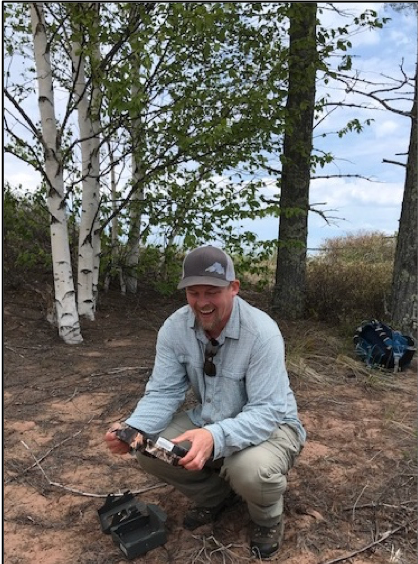
The activities are as follows:
- Teacher Guide
- Student activity, Graph Type A, Level 3
- Student activity, Graph Type B, Level 3
- Student activity, Graph Type C, Level 3
- Grading Rubric
- Digital Data Nugget on DataClassroom
Carnivores, animals that eat meat, captivate people’s interest for many reasons – they are charismatic, stealthy, and can be dangerous. Not only are they fascinating, they’re also ecologically important. Carnivores help keep prey populations in balance. They often target old, sick, or weak individuals. This results in more resources for healthier prey. Carnivores also impact prey’s behavior and population sizes, which can have further effects down the food web. For example, if there are too many herbivores, such as deer, the plants in an ecosystem may be eaten to a point where they can’t survive. In this way, carnivores help the plant community by either reducing the number of herbivores in an ecosystem, or changing how or where prey forage for food.
Despite their importance and our interest in carnivores, they are very hard to monitor. Not only do they have naturally low population sizes because they are at the top of the food chain, they also have a natural ability to hide and blend into their environment. Erik is a wildlife biologist who is interested in taking on this challenge. He wants to learn more about carnivores and what factors affect where they live. Learning more about where carnivores are found can help scientists with conservation efforts.
Erik lives on the southern shore of Lake Superior, the largest lake (by area) in the world. This area is home to the Apostle Islands National Lakeshore – including 21 islands and a 12-mile stretch of the mainland in northern Wisconsin. The Apostle Islands vary in many ways – size, distance from the mainland, highest elevation, historical and current human use, plant communities, and even small differences in climate. The islands are so remote that scientists really didn’t know which carnivores lived on the islands. There is evidence from historical reports that red fox and coyotes lived on some of the islands. More recently, black bears have been observed by visitors as they are hiking or camping. Erik wanted to know which species of carnivores are on each island. As he began to explore methods to document wildlife on the islands, Erik and his collaborators were shocked to discover that American martens, Wisconsin’s only state endangered species, live on some of the islands.
Erik thought a promising step in learning more about what drives carnivores to live on different islands in the archipelago would be to apply what has been learned from islands in the ocean. He referred to a fundamental theory in ecology called the theory of island biogeography. This theory predicts that island size and its distance to the mainland affects the biodiversity, or number of species, found on that island. Specifically, larger islands will have higher carnivore biodiversity because there are more resources and space to support more species than smaller areas. In contrast, islands farther away from the mainland will have lower carnivore biodiversity because more isolated islands are harder for wildlife to reach.
Erik wanted to test whether the theory of island biogeography also applied to the Apostle Islands. Just like the classic research on island biogeography, some islands are closer to the mainland and they range in size. To inventory where each carnivore is found, Erik and his collaborators and students set up 164 wildlife cameras on 19 of the islands. They made their way out to the remote islands by boat and then bushwhacked their way to the sites, which are not along trails. Often this means they have to push through thick brush and climb over fallen trees, but it’s important to put the cameras in all habitat types, not just those that are enjoyable to walk through. When the research team arrived at a site, they mounted a camera on a tree at waist height. Whenever an animal came into the frame of a camera, a photo was taken and stored on a memory card. The cameras were left on the islands year-round from 2014-2019. Every 6 months Erik and his collaborators would traverse through the thick woods to swap out memory cards and batteries. During this time, they noticed that four of the cameras had not worked properly, so they used the pictures from 160 of the cameras.
Back at the college, the research team spent countless hours identifying which animals triggered the cameras. The cameras had taken over 200,000 photos over three years including 7,000 wildlife visits. Of these visits, 1,970 were from carnivores! They found 10 different kinds of carnivores, including: American marten, black bear, bobcat, coyote, fisher, gray fox, gray wolf, raccoon, red fox and weasels. After the pictures were processed, Erik used this information to map out which islands the animals were found. For this study, he used species richness, or the number of different species observed on each island, to answer his question.

Featured scientists: Erik Olson from Northland College, Tim Van Deelen, and Julie Van Stappen from the National Park Service. Support for this lesson was provided by the National Park Service with funding from the Great Lakes Restoration Initiative.
Flesch–Kincaid Reading Grade Level = 11.2
Additional teacher resources related to this Data Nugget:
The study and results described in this Data Nugget have been published:
- Allen, M.L., Farmer, M.J., Clare, J.J., Olson, E.R., Van Stappen, J., Van Deelen, T.R. 2018. Is there anybody out there? Occupancy of the carnivore guild in a temperate archipelago. Community Ecology 19(3): 272-280.
Citizen science site where students can view and identify animals found in pictures from cameras placed around Wisconsin.
There have been several news articles about this research:
